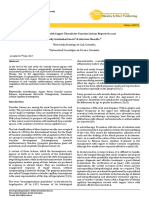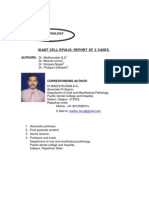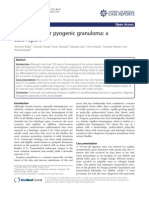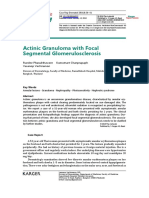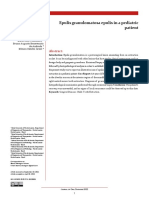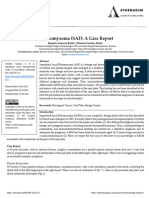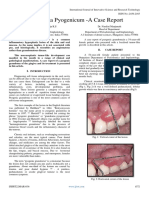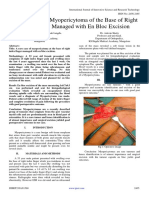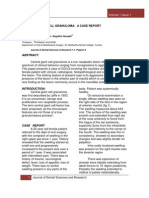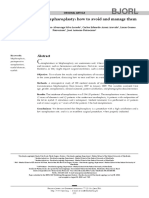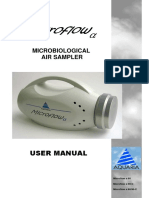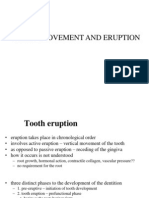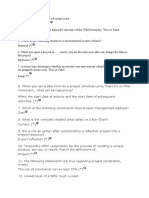Professional Documents
Culture Documents
Lobular Capillary Hemangioma An Extremely Rare Entity in The Retromolar Region Case Report
Original Title
Copyright
Available Formats
Share this document
Did you find this document useful?
Is this content inappropriate?
Report this DocumentCopyright:
Available Formats
Lobular Capillary Hemangioma An Extremely Rare Entity in The Retromolar Region Case Report
Copyright:
Available Formats
Volume 7, Issue 7, July – 2022 International Journal of Innovative Science and Research Technology
ISSN No:-2456-2165
Lobular Capillary Hemangioma: An Extremely Rare
Entity in the Retromolar Region: Case Report
Dr. Jambukeshwar Kumar B., Dr. Shreya H.R., Dr. Srikar M.V., Dr. Vidya K.C., Dr. Akshay Thilak
Abstract:- A benign growth of blood vessels called a the patient was under local anesthetic (1:80,000). Complete
hemangioma appears in both childhood and maturity. hemostasis was attained and bleeding was completely
Early infancy fast endothelial cell growth, followed by stopped by applying pressure with a gauze. Instructions and
involution throughout time, identify them as postoperative care were provided. For a standard
malignancies. Hemangiomas can be classified as either histological study, the removed tissue was sent in a formalin
capillary or cavernous. The capillary shape appears as a bottle (FIGURE 2 AND FIGURE 3). After a week, the
flat region made up of lots of tiny capillaries. Large patient was brought back in, and the biopsy site healing
dilated sinuses filled with blood make up a cavernous went smoothly and satisfactorily.(FIGURE 5B)
hemangioma, which presents as an elevated lesion of Additionally, the patient received recommendations for
vascular plexuses with a deep red color. They primarily surgically extracting 48 and 18 teeth.
affect white people more than people of color, are three
times more common in women than men, affect the II. HISTOPATHOLOGICAL REPORT:
mandible more than the maxilla in a 2:1 ratio, and only
five percent of intramuscular hemangiomas include the revealed discontinuous stratified squamous para-keratinized
masseter muscle. This case of a patient with a lobular epithelium of variable thickness overlying a vascular, fibro
capillary hemangioma is being described to highlight the cellular stroma associated with proteolytic changes, pseudo -
condition's uncommon occurrence and effective therapy. dysplasia and epithelial proliferation. underlying connective
tissue shows lobules of budding capillaries separated by
setae, with focal collections of plasma cells along with
I. INTRODUCTION
Russel bodies. Telangiectatic and congested capillaries are
Patient MANJULA A. S., a 26-year-old woman with a appreciated throughout the connective tissue (feeder vessel)
growth in the right lower back tooth region for 15 days, – final diagnosis of LOBULAR CAPILLARY
came to our department of oral and maxillofacial surgery at HEMANGIOMA. (FIGURES 6)
the Coorg Institute of Dental Sciences in Virajpet with this
complaint. The growth, which progressively grew in size, III. DISCUSSION
was first observed 15 days ago. Additionally, the patient had Hemangiomas, which can be categorized as capillary
a history of bleeding and chewing problems. Patient lacked or cavernous, are benign vascular tumors that are rather
any pertinent medical background. On intraoral frequent. Although capillary hemangiomas are a common
examination, a retromolar of tooth number 48 facing the soft tissue tumor of the head and neck, they are very
lingual side displayed a 1.5x1.5 cm single, pedunculated, uncommon in the oral cavity. A rapid growth phase is
reddish pink swelling with smooth surface and impingement followed by a slow involution in capillary hemangiomas,
of opposing 3rd molar tooth. The lesion's surface seems which are made up of numerous tiny capillaries lined with
ulcerated and white. (FIGURE 5A) endothelial cells and sustained in the connective tissue
All the inspectory results were verified upon palpation. stroma. The common soft tissue tumor of the oral cavity is
The lesion was firm in consistency, quickly bleeds when called pyogenic granuloma. The doctor typically faces
prodded, and was painful. On the digital pressure, clinical confusion and difficulty in diagnosing these two
compressibility and refilling of the lesion were visible. lesions. Hemangiomas are benign tumors that are more
Because the patient had a history of chewing betelnuts, pan common in children (7%) than adults1. Capillary
quid, and slaked lime 2-3 times per day during the previous hemangiomas are exceedingly uncommon intraorally,
six months, the patient had poor oral hygiene and stains. The occurring in 0.5%–1.0% of all other lesions with a female
radiograph (OPG) showed that there were 48 impacted and preference (ratio of 3:1). Nayouki Matsumoto et al.
18 buccal eruptions (FIGURE 4). A preliminary diagnosis of examined 31 capillary hemangioma patients and discovered
pyogenic granuloma was made based on the clinical that the majority of lesions were identified in the buccal
presentation of the lesion. Capillary hemangioma, peripheral mucosa (45.2%), tongue (35.5%), lip (9.7%%), gingiva
giant cell granuloma, and peripheral ossifying fibroma were (6.5%), and palate (3.2 percent).2
among the differential diagnoses. A biopsy was planned for Hemangiomas of the oral soft tissues can range in size
the same as an additional procedure. Oral prophylaxis and from a few millimeters to several centimeters and present as
patient education about maintaining good oral hygiene and painless, soft, smooth or lobulated, sessile or pedunculated
quitting the habit were performed after the patient provided lesions or growths. These lesions typically grow slowly and
informed consent. The results of the preoperative blood tests have a deep red or blue red tint when they first appear.
were all within normal limits. After a week, the patient was These lesions frequently include adjacent teeth and the
treated under aseptic conditions, and the growth and interdental papilla. They are typically painless3.
surrounding tissue were excised using electrocautery while Hemangiomas of the oral mucosa are managed differently
IJISRT22JUL492 www.ijisrt.com 1115
Volume 7, Issue 7, July – 2022 International Journal of Innovative Science and Research Technology
ISSN No:-2456-2165
depending on the patient's age, the size of the lesion, the surgical excision. Hemangiomas often bleed profusely
region of involvement, and the clinical characteristics of the during surgical excision, however in this case, there was
hemangioma. Surgery to remove the lesion, either with or little to no bleeding, suggesting that the hemangioma may
without ligating the vessels and embolization, is the most not be actively proliferating. The treatment had a positive
popular form of treatment for hemangiomas. Other effect on the patient5.
therapeutic approaches, including as steroid therapy,
electrosurgery, laser surgery, cryosurgery, and the use of IV. CONCLUSION
sclerosing agents, have recently also been developed.
Surgery should be performed carefully, keeping in mind the To understand the clinical behavior and potential
potential for intraoperative and postoperative bleeding4. dentoalveolar consequences of the capillary hemangioma,
early diagnosis and biopsy are required. Capillary
The lesion in this instance was less symptomatic and hemangioma is significant due to its associated vascular
unpleasant. To rule out malignant conditions and check for characteristics and consequences, despite the fact that it is a
the presence of any other foreign bodies that needed to be benign tumor of the oral cavity. Additionally, as the tissues
removed in addition to the lesion, radiographs were may bleed heavily both before and after surgery, surgical
indicated. The therapeutic method in this instance was care of hemangiomas should be done with prudence6.
FIGURE – 1A LEFT PROFLE FIGURE – 1B FRONTAL PROFILE FIGURE 1C – RIGHT PROFILE
Fig. 1 - EXTRA ORAL PICTURES
Fig. 2: EXCISIONED GROWTH MEASURING – 1.2*1*0.9 CM
IJISRT22JUL492 www.ijisrt.com 1116
Volume 7, Issue 7, July – 2022 International Journal of Innovative Science and Research Technology
ISSN No:-2456-2165
Fig. 3: SPECIMEN IN FORMALIN BOTTLE
Fig. 4: ORTHOPANTANOGRAM
IJISRT22JUL492 www.ijisrt.com 1117
Volume 7, Issue 7, July – 2022 International Journal of Innovative Science and Research Technology
ISSN No:-2456-2165
FIGURE 5A - PREOPERATIVELY
FIGURE 5B - POSTOPERATIVELY
Fig. 5: INTRA ORAL PICTURES
IJISRT22JUL492 www.ijisrt.com 1118
Volume 7, Issue 7, July – 2022 International Journal of Innovative Science and Research Technology
ISSN No:-2456-2165
FIGURE 6A FIGURE 6 B
Fig. 6: HISTOPATHLOGICAL PICTURES
REFRENCES
[1.] Dilsiz A, Aydin T, Gursan N. Capillary hemangioma
as a rare benign tumor of the oral cavity: a case report.
Cases journal. 2009 Dec;2(1):1-6.
[2.] Kumari VR, Vallabhan CG, Geetha S, Nair MS, Jacob
TV. Atypical presentation of capillary hemangioma in
oral cavity-A case report. Journal of Clinical and
Diagnostic Research: JCDR. 2015 Oct;9(10):ZD26.
[3.] Mills SE, Cooper PH, Fechner RE. Lobular capillary
hemangioma: the underlying lesion of pyogenic
granuloma. A study of 73 cases from the oral and nasal
mucous membranes. The American journal of surgical
pathology. 1980 Oct 1;4(5):470-9.
[4.] Lyssy LA, Puckett Y. Oral Hemangiomas. [Updated
2022 May 6]. In: StatPearls [Internet]. Treasure Island
(FL): StatPearls Publishing; 2022 Jan-. Available from:
https://www.ncbi.nlm.nih.gov/books/NBK560768/
[5.] Rachappa MM, Triveni MN. Capillary hemangioma or
pyogenic granuloma: A diagnostic dilemma.
Contemporary clinical dentistry. 2010 Apr;1(2):119.
[6.] Açikgözsurname A, Sakallioglu U, Özdamar S, Uysal
A. Rare benign tumours of oral cavity–capillary
haemangioma of palatal mucosa: a case report.
International Journal of Paediatric Dentistry. 2000
Jun;10(2):161-5.
IJISRT22JUL492 www.ijisrt.com 1119
You might also like
- 2005-2010 Tacoma Bed Extender PT329-35050 Rev. A - PT329-35050Document8 pages2005-2010 Tacoma Bed Extender PT329-35050 Rev. A - PT329-35050kylemac123No ratings yet
- Basics For BJJ SC - V3Document20 pagesBasics For BJJ SC - V3Teo Tolo100% (2)
- Experiment 91 Consumer ChemistryDocument8 pagesExperiment 91 Consumer ChemistryDascaliuc DanielNo ratings yet
- Pelton WheelDocument5 pagesPelton WheelMuhammedShafiNo ratings yet
- Resection of Localized Cheek Infantile HemangiomaDocument4 pagesResection of Localized Cheek Infantile HemangiomaindriNo ratings yet
- Retracted Oral HaemangiomaDocument5 pagesRetracted Oral Haemangiomaaulia lubisNo ratings yet
- A Case Report of A 55 Year Old Female With Epulis GranulomatosaDocument3 pagesA Case Report of A 55 Year Old Female With Epulis GranulomatosaIsmail YusufNo ratings yet
- 63 - CASE REPORT Epulis GranulomaDocument3 pages63 - CASE REPORT Epulis GranulomaRina NovitrianiNo ratings yet
- Weber Medicine & Clinical Case Reports ISSN:2449-1624: © Author(s) 2017. CC Attribution 3.0 LicenseDocument5 pagesWeber Medicine & Clinical Case Reports ISSN:2449-1624: © Author(s) 2017. CC Attribution 3.0 LicenseErika Majin MorenoNo ratings yet
- Granuloma ArticleDocument3 pagesGranuloma ArticleRamanpreet KourNo ratings yet
- Giant Cell Epulis: Report of 2 Cases.: Oral PathologyDocument11 pagesGiant Cell Epulis: Report of 2 Cases.: Oral PathologyVheen Dee DeeNo ratings yet
- UrineDocument4 pagesUrineVidhya MuruganNo ratings yet
- Report on Two Cases of Gingival Epulis LesionsDocument5 pagesReport on Two Cases of Gingival Epulis LesionsAnandNo ratings yet
- DiagnosisDocument4 pagesDiagnosisDiana RizkiNo ratings yet
- Granuloma Piogenik MultipelDocument6 pagesGranuloma Piogenik MultipelRizki NovrildawatiNo ratings yet
- Large Unusual Fibroepithelial Polyp Case ReportDocument4 pagesLarge Unusual Fibroepithelial Polyp Case ReportmuharrimahNo ratings yet
- A Case Report of Eruptive Syringoma: Clinical, Dermoscopic and Histological FeaturesDocument5 pagesA Case Report of Eruptive Syringoma: Clinical, Dermoscopic and Histological FeaturesIJAR JOURNALNo ratings yet
- Fibrous Hyperplasia - A Case ReportDocument4 pagesFibrous Hyperplasia - A Case ReportInternational Journal of Innovative Science and Research TechnologyNo ratings yet
- Actinic Granuloma With Focal Segmental GlomerulosclerosisDocument6 pagesActinic Granuloma With Focal Segmental Glomerulosclerosisranz ibonkNo ratings yet
- V 7 Aop 191Document3 pagesV 7 Aop 191Sekar EkaperdanaNo ratings yet
- Hemangioma Oral (Gill)Document4 pagesHemangioma Oral (Gill)koizorabigNo ratings yet
- JPNR - S04 - 233Document6 pagesJPNR - S04 - 233Ferisa paraswatiNo ratings yet
- 1482 5294 1 PBDocument5 pages1482 5294 1 PBNikola PachoovNo ratings yet
- Sialolithiasis of The Submandibular Gland: Lberg R. Relationship of Intraoperative Rupture ofDocument4 pagesSialolithiasis of The Submandibular Gland: Lberg R. Relationship of Intraoperative Rupture ofCoryza Gabrie tanNo ratings yet
- Adenoid Cystic Carcinoma of Hard Palate: A Case ReportDocument5 pagesAdenoid Cystic Carcinoma of Hard Palate: A Case ReportHemant GuptaNo ratings yet
- Ameloblastoma: Notorious Tumor of The Jaw - Report of A CaseDocument3 pagesAmeloblastoma: Notorious Tumor of The Jaw - Report of A CaseUwie MoumootNo ratings yet
- Frontal Sinus CholesteatomaDocument6 pagesFrontal Sinus CholesteatomaasiyazaidiaNo ratings yet
- Primary Haemangioma of The Skull: Case ReviewDocument3 pagesPrimary Haemangioma of The Skull: Case ReviewSoemantri Doank100% (1)
- Superficial Acral Fibromyxoma SAF A Case ReportDocument4 pagesSuperficial Acral Fibromyxoma SAF A Case ReportAthenaeum Scientific PublishersNo ratings yet
- Peripheral Giant Cell Granuloma - A Review and Case Report Jurnal 3Document6 pagesPeripheral Giant Cell Granuloma - A Review and Case Report Jurnal 3Trisna Budi UtamiNo ratings yet
- Cystic Hygroma in Elderly: A Case Report and Literature ReviewDocument3 pagesCystic Hygroma in Elderly: A Case Report and Literature ReviewAhsan JamilNo ratings yet
- Odontogenickeratocyst Clinically Mimicking Osteomyelitis - A Rare Case ReportDocument4 pagesOdontogenickeratocyst Clinically Mimicking Osteomyelitis - A Rare Case ReportInternational Journal of Innovative Science and Research TechnologyNo ratings yet
- Nasal Glioma A Rare Case in Maxillofacial Surgery Practice A Case ReportDocument5 pagesNasal Glioma A Rare Case in Maxillofacial Surgery Practice A Case ReportInternational Journal of Innovative Science and Research TechnologyNo ratings yet
- Granuloma Pyogenicum - A Case ReportDocument4 pagesGranuloma Pyogenicum - A Case ReportInternational Journal of Innovative Science and Research TechnologyNo ratings yet
- Shah VS, 2013Document4 pagesShah VS, 2013Bruna FerreiraNo ratings yet
- Hemangiopericytoma of Palate A Rare Case ReportDocument4 pagesHemangiopericytoma of Palate A Rare Case ReportIJAR JOURNALNo ratings yet
- Composite Hemangioendothelioma An Unusual Presentation of A Rare Vascular TumorDocument5 pagesComposite Hemangioendothelioma An Unusual Presentation of A Rare Vascular TumorTian Nopita SariNo ratings yet
- Excision of Epulis Granulomatosa in 8-Year-Old BoyDocument4 pagesExcision of Epulis Granulomatosa in 8-Year-Old BoyIsmail YusufNo ratings yet
- Capillary Hemangioma A Unique Entity in Mandibular Anterior Attached Gingiva A Case ReportDocument3 pagesCapillary Hemangioma A Unique Entity in Mandibular Anterior Attached Gingiva A Case ReportInternational Journal of Innovative Science and Research TechnologyNo ratings yet
- MainDocument5 pagesMainSheila FSifakNo ratings yet
- Bilateral Odontogenic Keratocyst in A NonsyndromicDocument5 pagesBilateral Odontogenic Keratocyst in A NonsyndromicRocio CacñahuarayNo ratings yet
- Giant Cell ReparativeDocument3 pagesGiant Cell ReparativeMedrechEditorialNo ratings yet
- ENT CaseDocument16 pagesENT CaseTee MatNo ratings yet
- A Rare Case of Myopericytoma of The Base of Right Index Finger Managed With en Bloc ExcisionDocument2 pagesA Rare Case of Myopericytoma of The Base of Right Index Finger Managed With en Bloc ExcisionInternational Journal of Innovative Science and Research TechnologyNo ratings yet
- Peripheral Giant Cell Granuloma - A Case ReportDocument4 pagesPeripheral Giant Cell Granuloma - A Case ReportAziz IkbalNo ratings yet
- Central Giant Cell Granuloma A Case ReportDocument5 pagesCentral Giant Cell Granuloma A Case ReportYara Arafat NueratNo ratings yet
- Aggressive Angiomyxoma A Case Series and Literature ReviewDocument8 pagesAggressive Angiomyxoma A Case Series and Literature ReviewafmzweybsyajeqNo ratings yet
- Management of Irritational Fibroma by Three Different Treatment Modalities - A Case SeriesDocument4 pagesManagement of Irritational Fibroma by Three Different Treatment Modalities - A Case SeriesInternational Journal of Innovative Science and Research TechnologyNo ratings yet
- Wa0086.Document9 pagesWa0086.Brampp HimawanNo ratings yet
- 2012 - Frympas G.Document8 pages2012 - Frympas G.alejandra gonzalezNo ratings yet
- International Journal of Pharmaceutical Science Invention (IJPSI)Document6 pagesInternational Journal of Pharmaceutical Science Invention (IJPSI)inventionjournalsNo ratings yet
- Point: How Do I Manage A Suspected Oral Vascular Malformation?Document3 pagesPoint: How Do I Manage A Suspected Oral Vascular Malformation?Luis Mesicano QuipeNo ratings yet
- Pradeep Kumar 2014Document5 pagesPradeep Kumar 2014srikantnairsemail8038No ratings yet
- Zheng2009 PDFDocument11 pagesZheng2009 PDFcintaNo ratings yet
- JIndianSocPedodPrevDent302179-1553084 041850Document4 pagesJIndianSocPedodPrevDent302179-1553084 041850NiNis Khoirun NisaNo ratings yet
- D0131011415 PDFDocument2 pagesD0131011415 PDFafm26No ratings yet
- Articol 10 PDFDocument6 pagesArticol 10 PDFIoanna Bianca HNo ratings yet
- Diode Laser Assisted For The Excision of Focal Epithelial Hyperplasia. Case ReportDocument5 pagesDiode Laser Assisted For The Excision of Focal Epithelial Hyperplasia. Case ReportInternational Journal of Innovative Science and Research TechnologyNo ratings yet
- Adult Abdominal Cystic Lymphangioma Revealed by Intra Peritoneal Hemorrhage A Case ReportDocument3 pagesAdult Abdominal Cystic Lymphangioma Revealed by Intra Peritoneal Hemorrhage A Case ReportInternational Journal of Innovative Science and Research TechnologyNo ratings yet
- Haemophilic Pseudotumours of The Limbs and Their Percutaneous TreatmentDocument5 pagesHaemophilic Pseudotumours of The Limbs and Their Percutaneous Treatmentyudhi kurniawanNo ratings yet
- Enucleation of AmeloblastomaDocument5 pagesEnucleation of Ameloblastomaayujunibarbie438No ratings yet
- Pterygium EmedicineDocument9 pagesPterygium EmedicineThomas SmithNo ratings yet
- Salivary Gland Cancer: From Diagnosis to Tailored TreatmentFrom EverandSalivary Gland Cancer: From Diagnosis to Tailored TreatmentLisa LicitraNo ratings yet
- Comparatively Design and Analyze Elevated Rectangular Water Reservoir with and without Bracing for Different Stagging HeightDocument4 pagesComparatively Design and Analyze Elevated Rectangular Water Reservoir with and without Bracing for Different Stagging HeightInternational Journal of Innovative Science and Research TechnologyNo ratings yet
- Diabetic Retinopathy Stage Detection Using CNN and Inception V3Document9 pagesDiabetic Retinopathy Stage Detection Using CNN and Inception V3International Journal of Innovative Science and Research TechnologyNo ratings yet
- The Utilization of Date Palm (Phoenix dactylifera) Leaf Fiber as a Main Component in Making an Improvised Water FilterDocument11 pagesThe Utilization of Date Palm (Phoenix dactylifera) Leaf Fiber as a Main Component in Making an Improvised Water FilterInternational Journal of Innovative Science and Research TechnologyNo ratings yet
- Advancing Healthcare Predictions: Harnessing Machine Learning for Accurate Health Index PrognosisDocument8 pagesAdvancing Healthcare Predictions: Harnessing Machine Learning for Accurate Health Index PrognosisInternational Journal of Innovative Science and Research TechnologyNo ratings yet
- Dense Wavelength Division Multiplexing (DWDM) in IT Networks: A Leap Beyond Synchronous Digital Hierarchy (SDH)Document2 pagesDense Wavelength Division Multiplexing (DWDM) in IT Networks: A Leap Beyond Synchronous Digital Hierarchy (SDH)International Journal of Innovative Science and Research TechnologyNo ratings yet
- Electro-Optics Properties of Intact Cocoa Beans based on Near Infrared TechnologyDocument7 pagesElectro-Optics Properties of Intact Cocoa Beans based on Near Infrared TechnologyInternational Journal of Innovative Science and Research TechnologyNo ratings yet
- Formulation and Evaluation of Poly Herbal Body ScrubDocument6 pagesFormulation and Evaluation of Poly Herbal Body ScrubInternational Journal of Innovative Science and Research TechnologyNo ratings yet
- Terracing as an Old-Style Scheme of Soil Water Preservation in Djingliya-Mandara Mountains- CameroonDocument14 pagesTerracing as an Old-Style Scheme of Soil Water Preservation in Djingliya-Mandara Mountains- CameroonInternational Journal of Innovative Science and Research TechnologyNo ratings yet
- The Impact of Digital Marketing Dimensions on Customer SatisfactionDocument6 pagesThe Impact of Digital Marketing Dimensions on Customer SatisfactionInternational Journal of Innovative Science and Research TechnologyNo ratings yet
- A Review: Pink Eye Outbreak in IndiaDocument3 pagesA Review: Pink Eye Outbreak in IndiaInternational Journal of Innovative Science and Research TechnologyNo ratings yet
- Auto Encoder Driven Hybrid Pipelines for Image Deblurring using NAFNETDocument6 pagesAuto Encoder Driven Hybrid Pipelines for Image Deblurring using NAFNETInternational Journal of Innovative Science and Research TechnologyNo ratings yet
- Design, Development and Evaluation of Methi-Shikakai Herbal ShampooDocument8 pagesDesign, Development and Evaluation of Methi-Shikakai Herbal ShampooInternational Journal of Innovative Science and Research Technology100% (3)
- A Survey of the Plastic Waste used in Paving BlocksDocument4 pagesA Survey of the Plastic Waste used in Paving BlocksInternational Journal of Innovative Science and Research TechnologyNo ratings yet
- Cyberbullying: Legal and Ethical Implications, Challenges and Opportunities for Policy DevelopmentDocument7 pagesCyberbullying: Legal and Ethical Implications, Challenges and Opportunities for Policy DevelopmentInternational Journal of Innovative Science and Research TechnologyNo ratings yet
- Hepatic Portovenous Gas in a Young MaleDocument2 pagesHepatic Portovenous Gas in a Young MaleInternational Journal of Innovative Science and Research TechnologyNo ratings yet
- Explorning the Role of Machine Learning in Enhancing Cloud SecurityDocument5 pagesExplorning the Role of Machine Learning in Enhancing Cloud SecurityInternational Journal of Innovative Science and Research TechnologyNo ratings yet
- Navigating Digitalization: AHP Insights for SMEs' Strategic TransformationDocument11 pagesNavigating Digitalization: AHP Insights for SMEs' Strategic TransformationInternational Journal of Innovative Science and Research TechnologyNo ratings yet
- Perceived Impact of Active Pedagogy in Medical Students' Learning at the Faculty of Medicine and Pharmacy of CasablancaDocument5 pagesPerceived Impact of Active Pedagogy in Medical Students' Learning at the Faculty of Medicine and Pharmacy of CasablancaInternational Journal of Innovative Science and Research TechnologyNo ratings yet
- Automatic Power Factor ControllerDocument4 pagesAutomatic Power Factor ControllerInternational Journal of Innovative Science and Research TechnologyNo ratings yet
- Mobile Distractions among Adolescents: Impact on Learning in the Aftermath of COVID-19 in IndiaDocument2 pagesMobile Distractions among Adolescents: Impact on Learning in the Aftermath of COVID-19 in IndiaInternational Journal of Innovative Science and Research TechnologyNo ratings yet
- Review of Biomechanics in Footwear Design and Development: An Exploration of Key Concepts and InnovationsDocument5 pagesReview of Biomechanics in Footwear Design and Development: An Exploration of Key Concepts and InnovationsInternational Journal of Innovative Science and Research TechnologyNo ratings yet
- Studying the Situation and Proposing Some Basic Solutions to Improve Psychological Harmony Between Managerial Staff and Students of Medical Universities in Hanoi AreaDocument5 pagesStudying the Situation and Proposing Some Basic Solutions to Improve Psychological Harmony Between Managerial Staff and Students of Medical Universities in Hanoi AreaInternational Journal of Innovative Science and Research TechnologyNo ratings yet
- The Effect of Time Variables as Predictors of Senior Secondary School Students' Mathematical Performance Department of Mathematics Education Freetown PolytechnicDocument7 pagesThe Effect of Time Variables as Predictors of Senior Secondary School Students' Mathematical Performance Department of Mathematics Education Freetown PolytechnicInternational Journal of Innovative Science and Research TechnologyNo ratings yet
- Drug Dosage Control System Using Reinforcement LearningDocument8 pagesDrug Dosage Control System Using Reinforcement LearningInternational Journal of Innovative Science and Research TechnologyNo ratings yet
- Securing Document Exchange with Blockchain Technology: A New Paradigm for Information SharingDocument4 pagesSecuring Document Exchange with Blockchain Technology: A New Paradigm for Information SharingInternational Journal of Innovative Science and Research TechnologyNo ratings yet
- Enhancing the Strength of Concrete by Using Human Hairs as a FiberDocument3 pagesEnhancing the Strength of Concrete by Using Human Hairs as a FiberInternational Journal of Innovative Science and Research TechnologyNo ratings yet
- Formation of New Technology in Automated Highway System in Peripheral HighwayDocument6 pagesFormation of New Technology in Automated Highway System in Peripheral HighwayInternational Journal of Innovative Science and Research TechnologyNo ratings yet
- Supply Chain 5.0: A Comprehensive Literature Review on Implications, Applications and ChallengesDocument11 pagesSupply Chain 5.0: A Comprehensive Literature Review on Implications, Applications and ChallengesInternational Journal of Innovative Science and Research TechnologyNo ratings yet
- Intelligent Engines: Revolutionizing Manufacturing and Supply Chains with AIDocument14 pagesIntelligent Engines: Revolutionizing Manufacturing and Supply Chains with AIInternational Journal of Innovative Science and Research TechnologyNo ratings yet
- The Making of Self-Disposing Contactless Motion-Activated Trash Bin Using Ultrasonic SensorsDocument7 pagesThe Making of Self-Disposing Contactless Motion-Activated Trash Bin Using Ultrasonic SensorsInternational Journal of Innovative Science and Research TechnologyNo ratings yet
- LP in ArtsDocument6 pagesLP in ArtsBilindaNo ratings yet
- Rui Zeng (Eds.) - Graphics-Sequenced Interpretation of ECG-Springer Singapore (2016) PDFDocument173 pagesRui Zeng (Eds.) - Graphics-Sequenced Interpretation of ECG-Springer Singapore (2016) PDFJulianNathanaelNo ratings yet
- Environmental Modifications: Nakul RangaDocument42 pagesEnvironmental Modifications: Nakul Rangataniamahapatra1No ratings yet
- A Poison Tree: Literature: Form 5 PoemDocument7 pagesA Poison Tree: Literature: Form 5 PoemRosli MohdNo ratings yet
- Teaching Plan: Objectives Identified Problems/Concerns Activities Evaluation Student Nurse Client/Family MemberDocument5 pagesTeaching Plan: Objectives Identified Problems/Concerns Activities Evaluation Student Nurse Client/Family MemberRaine SarmientoNo ratings yet
- Microflow Air Sampler User ManualDocument31 pagesMicroflow Air Sampler User Manualira rahmaNo ratings yet
- Skies of Arcadia - Lists (Cham, Moonfish, Discoveries)Document9 pagesSkies of Arcadia - Lists (Cham, Moonfish, Discoveries)123142asdadNo ratings yet
- VOLLEYBALL HISTORY AND RULESDocument12 pagesVOLLEYBALL HISTORY AND RULESJennybelle MolinaNo ratings yet
- Reflective EssayDocument5 pagesReflective Essaybwood17No ratings yet
- Lecture 9: Exploration and Exploitation: David SilverDocument47 pagesLecture 9: Exploration and Exploitation: David Silver司向辉No ratings yet
- CS601 - Machine Learning - Unit 2 - Notes - 1672759753Document14 pagesCS601 - Machine Learning - Unit 2 - Notes - 1672759753mohit jaiswalNo ratings yet
- Tooth Eruption and Movement MechanismsDocument8 pagesTooth Eruption and Movement MechanismsDrMohmed Mostafa100% (1)
- LA36300 Circuit Breaker Data SheetDocument2 pagesLA36300 Circuit Breaker Data SheetALEJANDRO DOMINGUEZNo ratings yet
- Bradford Protein Assay: Considerations For UseDocument4 pagesBradford Protein Assay: Considerations For UseRaja RajeshwariNo ratings yet
- Poem PDFDocument6 pagesPoem PDFTaylor JohnsNo ratings yet
- Fishing and Hunting Gear From Osseous Raw Materials in The Early Neolithic From SerbiaDocument12 pagesFishing and Hunting Gear From Osseous Raw Materials in The Early Neolithic From SerbiaDanaGrujićNo ratings yet
- The Wall Street Journal - 24-11-2021Document30 pagesThe Wall Street Journal - 24-11-2021Samuel GiovanelliNo ratings yet
- Differences Between Circuit Switching and Packet SwitchingDocument7 pagesDifferences Between Circuit Switching and Packet Switchingdebs icapsNo ratings yet
- Plant Toxicology, Fourth Edition (Books in Soils, Plants, and The Environment) PDFDocument664 pagesPlant Toxicology, Fourth Edition (Books in Soils, Plants, and The Environment) PDFFahad JavedNo ratings yet
- FinalDocument6 pagesFinalIwan IwanNo ratings yet
- 5S Office OrganizationDocument14 pages5S Office Organizationthuy linh phamNo ratings yet
- TD Polyfloor-SealerDocument12 pagesTD Polyfloor-SealerDhani RamadhanNo ratings yet
- Cobra 4 Far DynacordDocument4 pagesCobra 4 Far DynacordDaniel SfichiNo ratings yet
- Sir James ChadwickDocument6 pagesSir James ChadwickMichael GuevarraNo ratings yet
- Roof Truss Installation GuideDocument12 pagesRoof Truss Installation GuideAwang Mahardy67% (3)
- Four Course Meal Plan and BudgetDocument5 pagesFour Course Meal Plan and BudgetPemphoNo ratings yet








